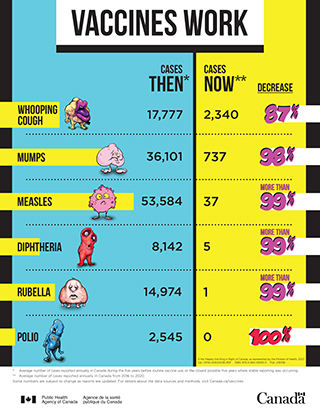Vaccines work: Case counts of 6 vaccine-preventable diseases before and after routine vaccination
| Disease | Cases then | Cases now | Decrease |
|---|---|---|---|
| Whooping cough | 17,777 | 2,340 | 87% |
| Mumps | 36,101 | 737 | 98% |
| Measles | 53,584 | 37 | More than 99% |
| Diphtheria | 8,142 | 5 | More than 99% |
| Rubella | 14,974 | 1 | More than 99% |
| Polio | 2,545 | 0 | 100% |
Definitions:
Cases then: Average number of cases reported annually in Canada during the:
- 5 years before routine vaccine use or
- closest possible 5 years where stable reporting was occurring
Cases now: Average number of cases reported annually in Canada from 2016 to 2020.
Some numbers are subject to change as reports are updated. For details about the data sources and methods, refer to vaccines and immunization.

Download in PDF format
(6.39 MB, 1 page)
- Organization: Public Health Agency of Canada
- Date published: 2023-08-18